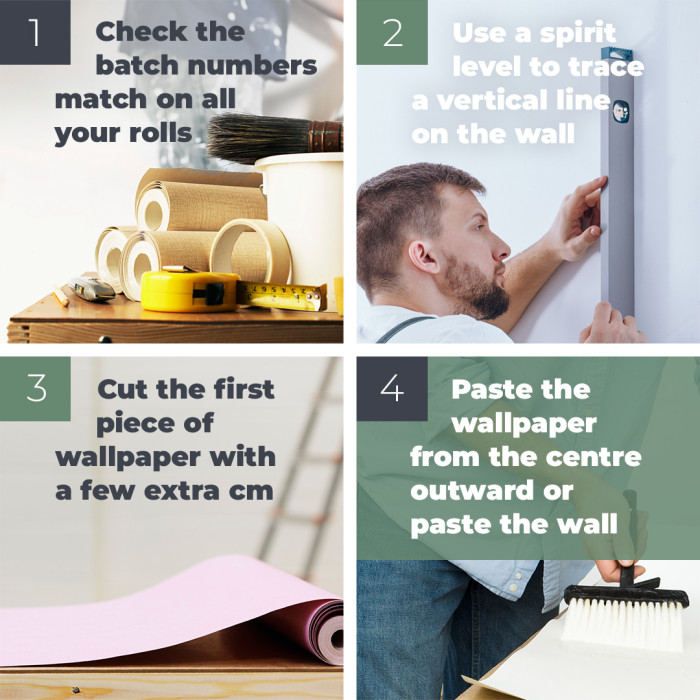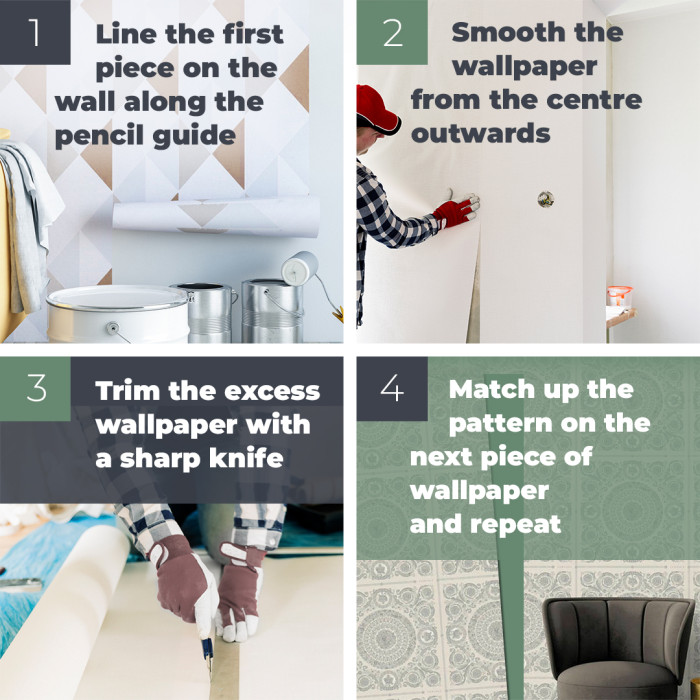Bringing your design dreams to life can be simultaneously exciting and overwhelming. Today we are going to show you how to put up wallpaper.
With a clear idea about how your decor transformation will look, you’ll be eager to complete your project to make your home look its best.
Wallpaper is an obvious place to start your home makeover, with various colours and styles available in our expertly curated collection.
Now that you’ve chosen your perfect fit, follow our guide on how to wallpaper your home. In this guide, we will explore the preparation needed, how to paste and how to hang wallpaper for a seamless finish.
Table of Contents
- What tools do I need?
- Preparation for putting up wallpaper.
- How to paste the wallpaper.
- How to hang up wallpaper.
- How long does wallpaper take to dry?
What tools do I need?
Before starting your wallpapering project, ensure you have all the necessary tools and equipment for a seamless project.
For preparation:
Sanding paper | Spirit level or plumb line | Pencil | Tape measure | Clean sponge | Scissors
For pasting:
Paste brush | Bucket of water | Pasting table
For hanging:
Smoother brush | Sharp Stanley knife | Seam roller
Preparing the wall
Follow these simple steps to prepare the wall to ensure that your new wallpaper will hang seamlessly.
Remove any existing wallpaper
When you remove wallpaper, it can be easy to accidentally leave small pieces of wallpaper stuck to the wall. Completely removing the wallpaper will prevent any creases or air bubbles from forming when you hang up your new wallpaper.
Remove any fixings on the walls
If you have any fixings on the wall, for hanging mirrors or photographs, for example, unscrew the fixings before you start to prevent them from ripping through the paper.
Of course, this means that they can be difficult to find after you have hung your new wallpaper. The solution? Matchsticks.
Cut a matchstick, or something similar, into smaller segments – removing the head – and place them into the holes where your picture hooks were. As you hang your paper, press it gently onto the matchstick to make a mark. Just be sure to remove the stick before you smooth the paper down to prevent it from ripping.
Ensure the wall is smooth
Fill in any holes or cracks visible in the wall to ensure that your surface is smooth. This will prevent any bumps or creases when you hang your new wallpaper.
It may also be worth lining the walls with lining paper to prevent your new wallpaper from shrinking, causing gaps between the sheets. Lining paper is also useful if your wall has any stains or imperfections, especially if you hang a light-coloured wallpaper.
Prepare newly plastered walls
Freshly plastered walls will provide a smooth surface for hanging your wallpaper. However, they still require preparation.
Bare plaster should always be primed and allowed to dry before wallpapering as this will seal the porous surface of the wall and help the wallpaper to better stick to the wall.

Use sandpaper to rough up painted walls
If you’re looking to wallpaper over painted walls, gently sandpaper the surface; otherwise, the adhesive may not attach properly to the wall.
Apply a layer of primer and allow it to dry before applying the wallpaper.
Use a sponge to clean the wall
Use a clean sponge to remove dust, dirt or grease from your wall so your wallpaper will hang flat to the surface without any bubbles or grease marks.
How to paste wallpaper
Preparation for hanging your wallpaper follows the same process, differing only depending on whether you are pasting the wallpaper or pasting the wall.
Check that your batch numbers match
Before starting any preparation, check that the batch numbers on your rolls of wallpaper are the same. This is essential as colours and finishes can vary slightly between batches.
Find the batch number printed on the label and double-check so your wallpaper has a coherent look.
Prepare the paste
Follow the instructions on your chosen paste and mix as per the brand’s instructions.
Trace a vertical line
Measure the width of your wallpaper, then use a spirit level, a plumb line, and a pencil to draw a vertical line on the wall. Draw the line a wallpaper width away from the corner and add a few centimetres over. This will give you a guide for when you hang the paper to ensure it is straight.

Cut the wallpaper
Cut the first piece at the same height as the wall with an extra bit at the top and bottom so you can trim it off after it has been hung.
Paste the wallpaper
If you are using paste-the-paper wallpaper, apply a generous amount of paste and coat the wallpaper, working from the centre outwards. Make sure that all the edges are well covered.
Prevent any paste from getting on the display side of the wallpaper, as it can damage the surface.
Paste the wall
For paste-the-wall wallpaper, apply your paste directly onto the wall. Be sure to paste beyond where the edge of the paper will be placed.
How to hang wallpaper
Line it up
Line the first piece of wallpaper up against the vertical pencil line to ensure it is straight and allow the extra length to hang over the top and bottom of the wall.
Smooth it out
When you’re happy with its position, use a wallpaper smoother to smooth the wallpaper from the centre outwards to get rid of any crinkles or bubbles.

Trim the edges
Trim the excess paper you left to hang over the edges using a Stanley knife and a ruler.
Apply the next piece
When you apply the next piece of wallpaper, match up the pattern to the first piece of wallpaper and then paste it on. Wipe off any excess paste with a clean sponge to remove it, and repeat until you’ve covered your space.
How long does wallpaper take to dry?
Wallpaper can take different amounts of time to dry depending on the paper and the condition of the room. It is usually between 24-48 hours but can take up to seven days or more.
Please join us on Instagram for lots more inspiration.
